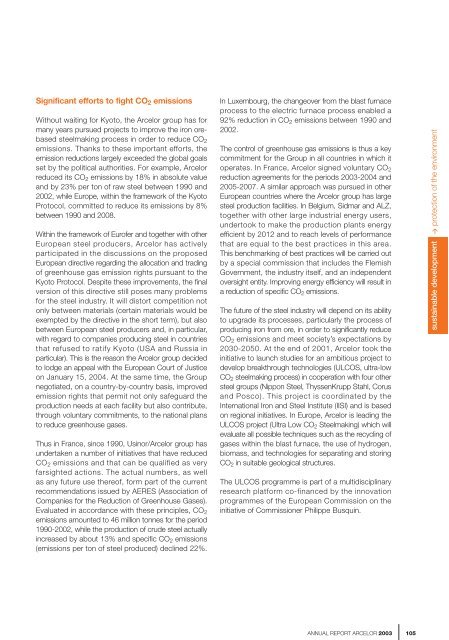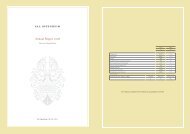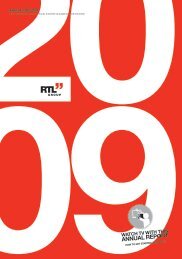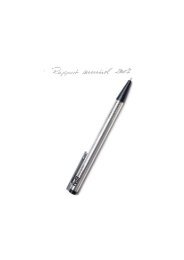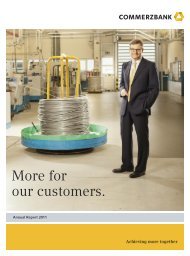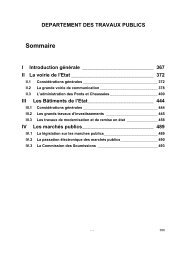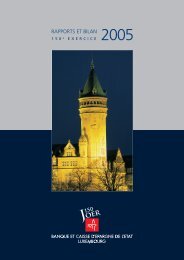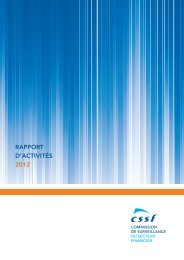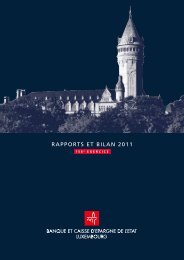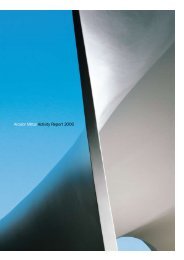ANNUAL REPORT ARCELOR 2003 - paperJam
ANNUAL REPORT ARCELOR 2003 - paperJam
ANNUAL REPORT ARCELOR 2003 - paperJam
You also want an ePaper? Increase the reach of your titles
YUMPU automatically turns print PDFs into web optimized ePapers that Google loves.
Significant efforts to fight CO 2 emissionsWithout waiting for Kyoto, the Arcelor group has formany years pursued projects to improve the iron orebasedsteelmaking process in order to reduce CO 2emissions. Thanks to these important efforts, theemission reductions largely exceeded the global goalsset by the political authorities. For example, Arcelorreduced its CO 2 emissions by 18% in absolute valueand by 23% per ton of raw steel between 1990 and2002, while Europe, within the framework of the KyotoProtocol, committed to reduce its emissions by 8%between 1990 and 2008.Within the framework of Eurofer and together with otherEuropean steel producers, Arcelor has activelyparticipated in the discussions on the proposedEuropean directive regarding the allocation and tradingof greenhouse gas emission rights pursuant to theKyoto Protocol. Despite these improvements, the finalversion of this directive still poses many problemsfor the steel industry. It will distort competition notonly between materials (certain materials would beexempted by the directive in the short term), but alsobetween European steel producers and, in particular,with regard to companies producing steel in countriesthat refused to ratify Kyoto (USA and Russia inparticular). This is the reason the Arcelor group decidedto lodge an appeal with the European Court of Justiceon January 15, 2004. At the same time, the Groupnegotiated, on a country-by-country basis, improvedemission rights that permit not only safeguard theproduction needs at each facility but also contribute,through voluntary commitments, to the national plansto reduce greenhouse gases.Thus in France, since 1990, Usinor/Arcelor group hasundertaken a number of initiatives that have reducedCO 2 emissions and that can be qualified as veryfarsighted actions. The actual numbers, as wellas any future use thereof, form part of the currentrecommendations issued by AERES (Association ofCompanies for the Reduction of Greenhouse Gases).Evaluated in accordance with these principles, CO 2emissions amounted to 46 million tonnes for the period1990-2002, while the production of crude steel actuallyincreased by about 13% and specific CO 2 emissions(emissions per ton of steel produced) declined 22%.In Luxembourg, the changeover from the blast furnaceprocess to the electric furnace process enabled a92% reduction in CO 2 emissions between 1990 and2002.The control of greenhouse gas emissions is thus a keycommitment for the Group in all countries in which itoperates. In France, Arcelor signed voluntary CO 2reduction agreements for the periods <strong>2003</strong>-2004 and2005-2007. A similar approach was pursued in otherEuropean countries where the Arcelor group has largesteel production facilities. In Belgium, Sidmar and ALZ,together with other large industrial energy users,undertook to make the production plants energyefficient by 2012 and to reach levels of performancethat are equal to the best practices in this area.This benchmarking of best practices will be carried outby a special commission that includes the FlemishGovernment, the industry itself, and an independentoversight entity. Improving energy efficiency will result ina reduction of specific CO 2 emissions.The future of the steel industry will depend on its abilityto upgrade its processes, particularly the process ofproducing iron from ore, in order to significantly reduceCO 2 emissions and meet society’s expectations by2030-2050. At the end of 2001, Arcelor took theinitiative to launch studies for an ambitious project todevelop breakthrough technologies (ULCOS, ultra-lowCO 2 steelmaking process) in cooperation with four othersteel groups (Nippon Steel, ThyssenKrupp Stahl, Corusand Posco). This project is coordinated by theInternational Iron and Steel Institute (IISI) and is basedon regional initiatives. In Europe, Arcelor is leading theULCOS project (Ultra Low CO 2 Steelmaking) which willevaluate all possible techniques such as the recycling ofgases within the blast furnace, the use of hydrogen,biomass, and technologies for separating and storingCO 2 in suitable geological structures.The ULCOS programme is part of a multidisciplinaryresearch platform co-financed by the innovationprogrammes of the European Commission on theinitiative of Commissioner Philippe Busquin.sustainable development > protection of the environment<strong>ANNUAL</strong> <strong>REPORT</strong> <strong>ARCELOR</strong> <strong>2003</strong> 105


